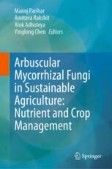Search
Search Results
-
Glomalin and Carbon Sequestration in Terrestrial Ecosystems
The fungi in Glomeromycota are mutualistic symbionts of plant roots and produce a special glycoprotein called “glomalin” on their spores and mycelium...
-
Use of Biochar for Biological Carbon Sequestration
Biochar (BC) is produced by pyrolysis process, i.e., when crop residues, biomass, grass, trees, or other plants are combusted at temperatures of...
-
Carbon Sequestration in Agroforestry: Enhancement of Both Soil Organic and Inorganic Carbon
In India owing to its gradation in climatic conditions from temperate to humid tropics, the agroforestry systems (AFS) and practices are highly...
-
Estimation on Individual-Level Carbon Sequestration Capacity of Understory Perennial Herbs
The carbon sequestration capacity of plants has been used as a nature-based solution to reduce carbon emissions. Perennial herbs potentially...

-
Role of silicon in phytolith-occluded carbon (PhytOC) sequestration
The sequestration of carbon (C) has been recognized as a crucial step in reducing global warming. Terrestrial biogeochemical C sequestration, coupled...

-
Diatom Algae for Carbon Sequestration in Oceans
Diatom algae are responsible for about 20–25% of primary production on Earth. They are said to have evolved ~200 million years ago (mya). Diatoms...
-
Drainage-Driven Loss of Carbon Sequestration of a Temperate Peatland in Northeast China
Drainage is known to reduce carbon sequestration in peatlands, but its effect on the stability of carbon pool and changes in recalcitrant organic...

-
Soil Carbon Sequestration: Facts and Challenges (Analytical Review)
AbstractThe study is focused on assessing the carbon sequestration depending on the methods of soil enrichment with organic materials. The level of...

-
Paths of Carbon Sequestration in Land Use (Literature Review)
Abstract—This review is devoted to a modern environmental problem: reducing greenhouse gases (GHGs) in the atmosphere. A significant proportion of...
-
An overall review on influence of root architecture on soil carbon sequestration potential
Soil carbon sequestration is a vital ecosystem function that mitigates climate change by absorbing atmospheric carbon dioxide (CO 2 ). Root...

-
Soil and Ocean Carbon Sequestration, Carbon Capture, Utilization, and Storage as Negative Emission Strategies for Global Climate Change
Carbon is stored in vegetation, soils, woody products, and aquatic habitats through biological carbon sequestration. Biological carbon sequestration...

-
Enhanced Weathering to Enhance Carbon Sequestration in Sandy Soils
The use of basalt, olivine, dolomite, or crushed concrete fines as an agricultural soil amendment provides a promising method of carbon...
-
Valuation of Madhupur Sal Forest Ecosystem Services and Carbon Sequestration Potency in Bangladesh: an Avenue for Mitigating Climate Change Impact
AbstractForested areas provide various services, including crucial carbon sequestration for climate change mitigation. The Madhupur Sal Forest (MSF)...

-
Tibetan Plateau grasslands might increase sequestration of microbial necromass carbon under future warming
Microbial necromass carbon (MNC) can reflect soil carbon (C) sequestration capacity. However, changes in the reserves of MNC in response to warming...

-
Soil Organic Carbon Sequestration
Terrestrial biomes in the U.S. can be managed for SOC sequestration. Sequestration for climate change adaptation and mitigation occurs when the soil...
-
How important is carbon sequestration in phytoliths within the soil?
Background and aimsAn overlooked fraction of the terrestrial carbon (C) pool is that associated with biogenic silica deposited in plants...

-
Topsoil Regeneration and Bio-sequestration
Soil regenerating is a type of ecological regeneration within the field of restoration ecology, it is the process of creating new soil and...
-
„Carbon sequestration“ durch Humusanreicherung in Obstanlagen?
The objective of the present work is to investigate possibilities of enriching soil organic carbon (SOC) and humus in fruit orchards as an ecosystem...

-
Plant height as an indicator for alpine carbon sequestration and ecosystem response to warming
Growing evidence indicates that plant community structure and traits have changed under climate warming, especially in cold or high-elevation...

-
Role of AMF in Organic Matter Decomposition, Carbon Sequestration and Climate Change Mitigation
Most land plants and abundant soil fungi in the phylum of Glomeromycota create arbuscular mycorrhizal fungal (AMF) symbiosis, promoting nutrient...
